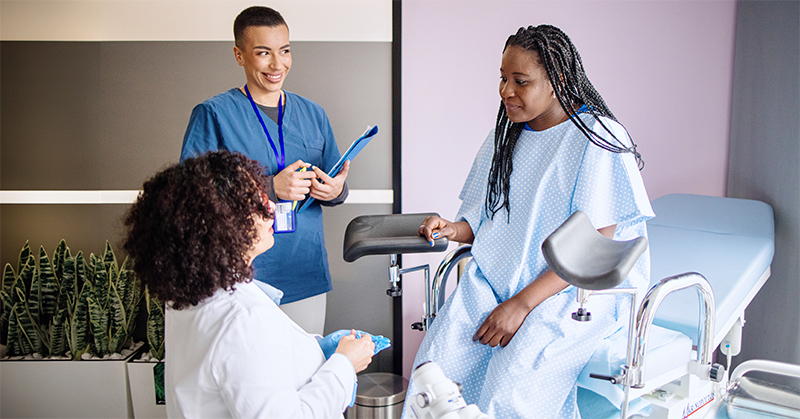
Around 200 million girls and women worldwide live with endometriosis, a disease in which tissue similar to the lining of the uterus grows in other places in the body. It is one of the most common gynecological diseases, with symptoms that include pelvic pain, fatigue, and infertility. Those who have the disease often endure a long, difficult path to diagnosis and effective treatment.
NIH’s Eunice Kennedy Shriver National Institute of Child Health and Human Development (NICHD) recently held a panel discussion about advances and new directions in endometriosis research. The discussion followed a screening of the 2023 documentary Below the Belt , a film by director Shannon Cohn, which follows a diverse group of people with endometriosis as they navigate their diagnosis, symptoms, and treatment options.
Panel participants include:
- Diana W. Bianchi, M.D., director, NICHD
- Janine Clayton, M.D., FARVO, director, NIH Office of Research on Women’s Health (ORWH)
- Stacey A. Missmer, Sc.D., professor of Obstetrics, Gynecology, and Reproductive Biology, Michigan State University
- Shannon Cohn
, director, Below the Belt
- Moderator: Candace Tingen, Ph.D., chief of the NICHD Gynecologic Health and Disease Branch
The Q&A has been edited for length and clarity.
All too often, women—and especially women of color—are dismissed when they talk to their doctors about their pain and symptoms that might relate to endometriosis. Why is it important to elevate awareness and education around this, particularly for women of color who are experiencing this disease?
 Dr. Janine Clayton: Data show that female patients in pain are less likely to be considered as having severe pain, and their pain is underestimated compared to male patients. Unfortunately, race is also a factor that sometimes results in bias and how clinicians evaluate individuals presenting with pain.
Dr. Janine Clayton: Data show that female patients in pain are less likely to be considered as having severe pain, and their pain is underestimated compared to male patients. Unfortunately, race is also a factor that sometimes results in bias and how clinicians evaluate individuals presenting with pain.
That's why it is so critical that we raise awareness so we can interrupt that bias and be mindful that people express their pain differently. We need to make sure that our medical providers, our nurses, and other individuals in the health care system not only receive education about endometriosis but also about pain, because the pain is the signal that something isn't right.
As a physician I usually say: You are the world's expert on your own body. I need to believe what you tell me. I need to understand what you're telling me, and we need to figure out what we can do to make you feel better regardless of what we do or don't know about that disease.
The White House recently launched its Initiative on Women's Health Research. How might this initiative make an impact on research for endometriosis and other reproductive diseases that affect women?
Dr. Clayton: The White House Initiative on Women’s Health Research says that at the highest level we are recognizing that we have to address our gaps in knowledge of women's health and that we have to accelerate research on the unique and specific health needs of women, such as endometriosis, across their lifespans. This initiative involves multiple government agencies.
It’s a very clear, very focused mission to advance women's health research in the United States. Endometriosis is specifically mentioned in the presidential memo, and we’re happy to see [the inclusion of] gynecologic conditions like pain and other important female-specific issues that deserve attention. We would love to see this bring more scientists from different disciplines to the field, to bring their skills and expertise for innovation from industry.
Public-private partnerships are called out in this presidential memo to accelerate progress because we want to make sure that advances from publicly funded research translate into practical benefits for health care providers, so that they know how to better treat people to relieve their symptoms.
It’s critical that we ensure that we also strengthen the workforce for people who are studying women's health so that we can train future researchers and increase public awareness. Everyone needs to understand how important this is and to make sure that women's health outcomes are prioritized.
Is there a link between endometriosis lesion size, lesion presence, or lesion stage and pain? Pain is a primary symptom in this disease, but how does that pain connect to the manifestations of the disease?
 Dr. Stacey Missmer: Pain is often ignored or minimized, yet it is typically the first expression of life-impacting endometriosis. Pain is one of the very confusing things about endometriosis. There is not a strong correlation between pain experience and what the disease looks like, its various manifestations, the volume of lesions, where they are, and how they change over time.
Dr. Stacey Missmer: Pain is often ignored or minimized, yet it is typically the first expression of life-impacting endometriosis. Pain is one of the very confusing things about endometriosis. There is not a strong correlation between pain experience and what the disease looks like, its various manifestations, the volume of lesions, where they are, and how they change over time.
One of the critical aspects that has been evolving is our understanding that what patients experience is very heterogeneous. While that is challenging, it is also a great gift. Both clinically and scientifically, we are leaning into those differences, being curious about the physiology that underlies them, but also focusing on what we need to discover to give clinicians the tools they need. So, when they first sit down with a patient, they know more about what characteristics of each patient they need to define and understand. That will help to precisely choose the best diagnostic and treatment pathways, leading us to better success with current treatments and to many possibilities for novel treatments.
Is there a link between endometriosis and autoimmune disorders?
Dr. Missmer: We know that there is an association between endometriosis and autoimmune conditions and that women with endometriosis have about double the risk for autoimmune conditions such as rheumatoid arthritis, lupus, and multiple sclerosis. We know that there is an immune dysregulation in those with endometriosis. This is leading to identification of novel anti-inflammatory pathways and chronic inflammation pathways and immune dysregulation relationships with endometriosis. Hopefully, this knowledge will lead to new treatments, but also a better understanding of menstrual health, menstrual function, and gynecology in general.
The path to diagnosis for someone with endometriosis can be long and circuitous. Because symptoms can start early in a women's life, it seems like that's a good point for intervention. How is NICHD exploring pathways for non-invasive diagnosis and new treatments?
 Dr. Diana Bianchi: NICHD is the major, if not exclusive, funder of endometriosis research at NIH. Our goal is to decrease that 7- to 10-year window that it takes to diagnose endometriosis, and we’re doing it in several ways. The ideal situation would be to make the diagnosis non-invasively, through finding some sort of blood-based biomarker—for example, mRNA or a protein that is expressed by cells from endometriosis lesions. We're also taking advantage of menstrual effluent, which is a highly neglected opportunity. Through our Small Business Innovation Research (SBIR) program, we’re funding NextGen Jane
Dr. Diana Bianchi: NICHD is the major, if not exclusive, funder of endometriosis research at NIH. Our goal is to decrease that 7- to 10-year window that it takes to diagnose endometriosis, and we’re doing it in several ways. The ideal situation would be to make the diagnosis non-invasively, through finding some sort of blood-based biomarker—for example, mRNA or a protein that is expressed by cells from endometriosis lesions. We're also taking advantage of menstrual effluent, which is a highly neglected opportunity. Through our Small Business Innovation Research (SBIR) program, we’re funding NextGen Jane research to find various markers in menstrual effluent that can be collected easily, non-invasively, and in the privacy of someone’s home.
Through the SBIR program, we also are funding development of non-hormonal therapeutics. The idea is that this therapeutic would kill endometrial cells at the source and prevent them from growing. We're also making progress in new and improved treatments, both in mouse models and in human beings. We've taken advantage of a technique that's used in cancer in which hyper-magnetic fields are used to kill cells. The endometrial cells have the potential to have magnetic nanoparticles administered to them, and researchers then can use this hyper-magnetic field to destroy those cells. It's working well in mice, it's reducing the lesions, and also enabling subsequent pregnancy in mice.
We previously funded development of compound that significantly reduces pain called elagolix (Orlissa ®) which is essentially a hormone blocker. It’s one of the only FDA-approved therapeutics for endometriosis pain. Another recently funded study has been looking at oleuropein, which is a compound that comes from olives that has the potential to treat endometrial cells.
Could you tell us about the new Office of Autoimmune Disease Research (OADR) within ORWH, its origins, and how endometriosis fits in?
Dr. Clayton: About 8% of people in the United States are living with an autoimmune disease, and nearly 80% of those people are women. So, the fact that women are so predominantly affected by autoimmune disease has made it important for many institutes and centers (ICs) at NIH. In 2022 Congress appropriated funds to form OADR within ORWH. Our inaugural director, Vicki Shanmugam, MBBS, MRCP, FACR, CCD, a renowned physician, scientist, and rheumatologist, will be helping us focus on a variety of autoimmune diseases.
Because we were able to support some endometriosis research last year through these funds, we are considering a wide range of autoimmune diseases or diseases with immune dysregulation as part of the remit of OADR. We will be working with all the ICs, as we do for almost everything we do, to drive some interdisciplinary approaches. We have so many questions, and we need to investigate many aspects. By bringing multiple disciplines together through interactive, interdisciplinary approaches, we hope that we'll be able to accelerate progress through OADR. We are looking forward to working further with all the ICs, in particular the National Institute of Arthritis Musculoskeletal and Skin Diseases and the National Institute of Allergy and Infectious Diseases.
Endometriosis can be such a spectrum of disorders. How is research on the disease’s presentation in different individuals getting us to diagnosis, intervention, and treatments earlier? What progress are we seeing?
Dr. Missmer: A huge credit goes to NICHD, which has funded my team and others to look at multisystemic and the broader consequences and associations with endometriosis. Learning more about the different systems and pathways that are involved for some patients with endometriosis encourages curiosity from many different disciplines to bring together those footprints.
We're leaping forward in our knowledge, and that knowledge is critical to defining different presentations of endometriosis in terms of the varied symptoms that patients experience. Also, we're now starting to delve more deeply into patterns around basic science and biomarker technology. Work from Naoko Sasamoto, M.D., and Kathryn Terry, Sc.D., is looking at proteomic profiles, and we're starting to see that the proteins in the blood are different between those patients with endometriosis who are presenting with dysmenorrhea, compared to those who are presenting with cyclic pain or those who have autoimmune conditions.
We're seeing differences in the tissue-based mutations between endometriosis lesions that are deep and those that are superficial. That means that the treatment pathways may be very different between a woman who presents with certain characteristics and not others. It also may mean that we can identify who among those with endometriosis is at risk of developing another immune condition. For example, who with endometriosis is at risk of developing hypertension and heart disease? We can then craft a better understanding of what's driving that relationship. We also have intentional interventions to prevent and improve long-term health starting early in life, and not at the point when a person is already experiencing infertility or autoimmune conditions.
How does endometriosis fit into the NICHD Strategic Plan and how does NICHD support research in this area?
Dr. Bianchi: Our institute was founded as a life-course institute, not disease-based. When we were creating our strategic plan in 2020, we talked a lot about how it would be important to focus on conditions that had major gaps in knowledge and needed more research. We settled on endometriosis as one of our 10 aspirational goals in the strategic plan.
The goal was to do a better job of diagnosing, managing, and treating endometriosis because it affects 1 in 10 people who are born female. As we refresh our next strategic plan, I'm hoping that this increased focus on women's health research will align with some of the needs for endometriosis, but also with other painful diseases associated with gynecological health.
There are reasons to be optimistic. Between 2020 and 2022, the number of endometriosis projects that we funded has gone from 32 to 52 and the amount of total endometriosis funding at NIH has gone from $13 million to $27 million. What we've seen in other areas is when there's an infusion of funds it brings in new researchers from other disciplines, and it has an enormous impact on the field.
REFERENCE:
Sasamoto N et al., Plasma proteomic profiles of pain subtypes in adolescents and young adults with endometriosis. Human Reproduction. DOI: 10.1093/humrep/dead099 (2023)

 BACK TO TOP
BACK TO TOP